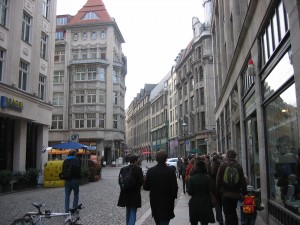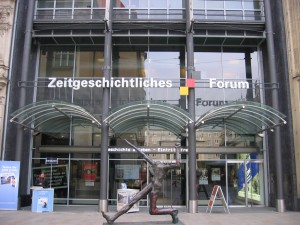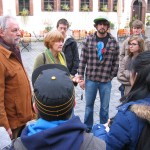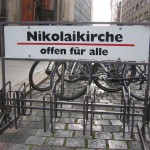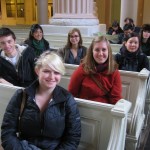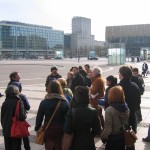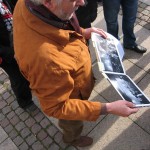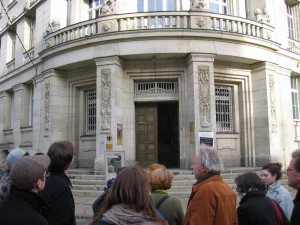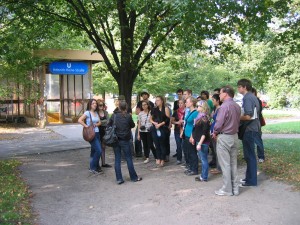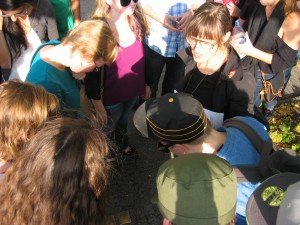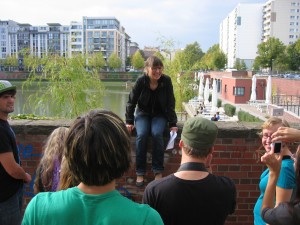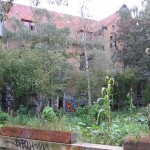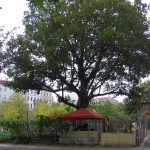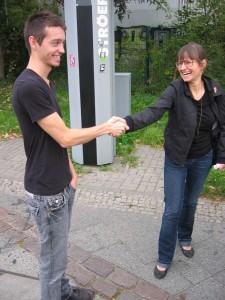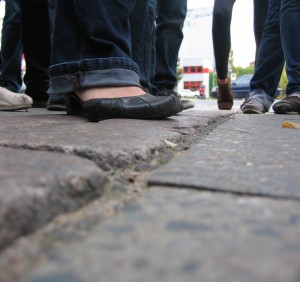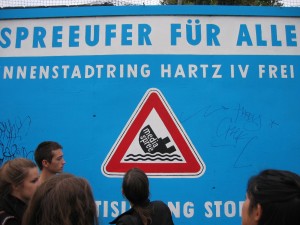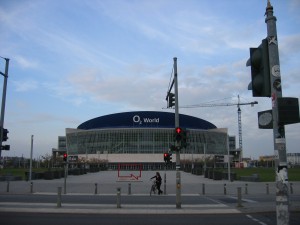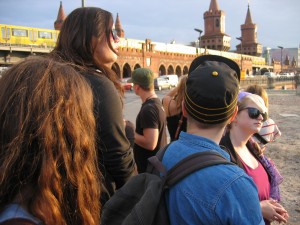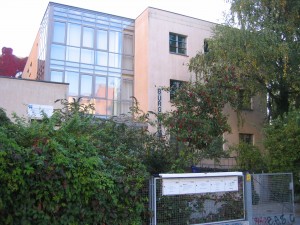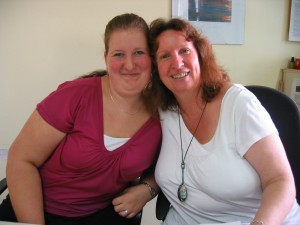A trip to Leipzig, epicenter of the Wende
This Friday we took a day trip to Leipzig to learn more about the events that led to the Wende – the momentous “turn” or “change” in 1989 that eventually led to the reunification of Germany.
Our first stop was the Zeitgeschichtliches Forum, a museum that focuses on the the resistance movement that was centered in Leipzig in the 1980s, and its eventual results in the “peaceful revolution.”
Afterwards, historians Dorothee Wierling and Bernd Lindner shared their expertise with us on the streets of Leipzig itself, taking us step-by-step along the route walked by the protesters here in 1989. The resistance movement first centered on the Nikolaikirche, a church where politically-charged “peace prayers” had already been taking place for several years. In 1989, attendance began to soar as people joined the movement to demand change.
As the number of protesters grew week by week, they dared to walk further and further along the “Ring” avenue that encircled the city center. Herr Lindner, who took part in the protests, helped us retrace their steps. (He augmented the experience with photos from a book he helped co-author – right.)
By November of 1989, 70,000 protesters were marching together peacefully through the streets of Leipzig. One of the last sites to be incorporated into their route was the Runde Ecke – the building housing the central offices of the Stasi.
As we approach the anniversary of the fall of the Wall, it’s good to remember that this revolution did not begin in Berlin, but in Leipzig. The capital is often privileged in the narrative of the Wende, but it couldn’t have happened without the courage of the protesters in this other key city.
A walk through our Kiez with Manuela Mangold
Manuela Mangold, a long-time Kreuzberger, gave us a fantastic tour of the students’ “Kiez” in Berlin on Tuesday afternoon. Kiez is a local word meaning “neighborhood,” but it denotes not just a district of the city (in this case, Kreuzberg), but one’s immediate, local surroundings — the place where everyday life is lived.
We started our tour at the Heinrich-Heine-Strasse U-Bahn station, the stop where the students regularly get onto the subway. During the time when Berlin was divided, it was a border crossing used mainly for commercial traffic. Below, the subway station was a “ghost station” — because the wall ran in a zig-zag manner from roughly the southeast to the northwest, trains going from this part of West Berlin would pass under East Berlin on their way to other parts of West Berlin would pass through a completely darkened (and sometimes guarded) station.
Next on our tour was an example of Stolpersteine (“Stumble Stones”), an art project begun in Cologne, but which has left its mark all over Berlin. A form of Holocaust memorial, it marks where victims of the tragedy once lived. People are meant to “stumble” over these on their daily walks, a constant reminder of the importance of remembering the Holocaust, and its impact on life here.
We continued with a look at the path of the Berlin Wall and death strip. Manuela is sitting right between former East and West in the picture! As in most of Berlin, it’s been restored so nicely now that barely a trace of the division remains.
Oppositional culture has been a huge part of Kreuzberg’s identity since the 1970s. Here are two examples of “squatter” culture — both built right up against the Wall. One is a famous house squat, and the other a garden built right in the shadow of the wall, in what was technically East German territory!
We continued along the path of the wall, which is (in some places) marked by a strip of brick set into the ground. (Dominic represented East Germany, shaking hands with a West Berliner!)
Leaving our Kiez and crossing the Spree River, we continued on to talk about the politics of development along the river banks, another area where squatters and other oppositional movements have traditionally made their homes. Now big developers are buying up large swaths of property, driving up rents and bringing a whole new feel to the neighborhood, garnering vehement protest from locals. One glaring example of this is O2 World, a large concert venue whose undeniably corporate aura conflicts tangibly with its surroundings. Its VIP entrance along the river was heavily protested, but got built anyway.
We ended our tour at the Oberbaumbrücke, which was also divided by the Wall. Now, as you can see in the background, the U1 train line can run all the way across it again!
Our Kiez is in some ways the perfect spot for the students, sitting uncomfortably amidst the former East and West, scarred with layers of memory and history – and still transforming before our eyes.
getting to know our Beamtinnen
An important part of doing anything bureaucratic in Berlin (e.g. signing up for an internet plan, or registering at the university) is to get something called an Anmeldebestätigung: a “proof of registration” with the city. Because we’re such a big group, John, Eleanor, Chance and I handled the registration for everyone. This involved, first, going to the district registration office (basically the Berlin equivalent of the DMV, though they handle a lot more than just driver’s licenses!) and standing in a very long line. When we told the woman behind the counter that we had 24 people to register, she looked at us incredulously and said that it was absolutely impossible without an appointment — if she tried to get us in that afternoon, they’d have to shut the whole place down just to get our paperwork done!
She may have been slightly exaggerating, but in any case, she was very helpful in the end, because she sent us directly to the manager of the office, who quite gladly made us an appointment for 8am the next morning.
The next morning, we met these two lovely ladies – Frau Pierags and Frau Pfotenhauer – who got us all registered. It took about 2 1/2 hours, and we had a few hiccups along the way, but thanks to a very helpful student with a cell phone (who woke his colleagues up to ask them what cities they were born in – info that was missing on the forms), a visit from one other who had previously registered in Berlin, and one last trek back to the office in the afternoon to change a wrong date … we got it done!
In the mean time, I became acquainted with our Beamtinnen (civil servants) and learned quite a bit about Krezuberg-Friedrichshain (which now count as one district after a consolidation a few years ago), as well as what it takes to do their job (lots and lots of knowledge about different things, and an ability to work with people). We also chatted about why the German word for “Indian Summer” is Altweibersommer (the dewy cobwebs on the trees look like old women’s hair), various fun things to do in Berlin, and why it’s difficult to live far away from one’s family.
Speaking of being far away, the students have also told me this week that they’re experiencing some pretty hefty culture shock. It’s all part of the process, and hopefully having that Anmeldebestätigung will make it a tiny bit easier …
tags
the author
I'm a doctoral student at CUNY Graduate Center. I'm thrilled to be teaching the CHID Berlin program with Prof. John Toews! You can contact me at naraelle [at] gmail.com, or find out more about me at www.naraelle.net.
Blogroll
- Annie Holden's blog
- Cassie Hoeprich's blog
- Dominic Barrera's blog
- Janet Williams's blog
- Mariah Alderete's blog
- Melissa Au's blog
- Robert Hampton's blog
- UW Students Study Abroad Our students Natalie and Cassie are contributing to the official IPE student blog this fall!



